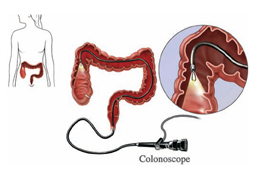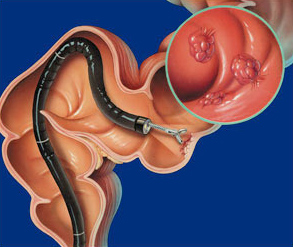Colonoscopy
 The term colonoscopy refers to a medical procedure during which a long flexible tube is used to look inside the colon. It is a procedure performed by a gastroenterologist, a well-trained specialist.
The term colonoscopy refers to a medical procedure during which a long flexible tube is used to look inside the colon. It is a procedure performed by a gastroenterologist, a well-trained specialist.
The main instrument that is used to look inside the colon is the colonoscope. The colonoscope is a long, thin, flexible tube with a tiny video camera and a light on the end. By adjusting the various controls on the colonoscope, the gastroenterologist can carefully guide the instrument in any direction to look at the inside of the colon. The high-quality picture from the colonoscope is shown on a TV monitor, and gives a clear, detailed view.
Uses of Colonoscopy
Colonoscopy is an important way to check for colon cancer and to treat colon polyps. Polyps are abnormal growths on the inside lining of the intestine; they vary in size and shape and while most polyps are not cancerous, some may turn into cancer. However, it is not possible to tell just by looking at a polyp if it is malignant or potentially malignant. This is why colonoscopy is often used to remove polyps, a technique called a polypectomy.
 Colonoscopy is also a safe and effective way to evaluate problems such as:
Colonoscopy is also a safe and effective way to evaluate problems such as:
- Blood loss.
- Abdominal or rectal pain.
- Changes in bowel habits, such as chronic diarrhea.
- Abnormalities that may have first been detected by other studies, such as an inflamed colon noted on a CT scan of the abdomen.
- Active bleeding from the large bowel.
Another advantage of the procedure is that, when needed, other instruments can be passed through the colonoscope. These may be used, for example, to painlessly remove a suspicious-looking growth or to biopsy, that is, take a small piece of tissue for further analysis. In this way, colonoscopy may help to avoid surgery or to better define what type of surgery may need to be done.
A shorter version of the colonoscope is called a sigmoidoscope. This instrument is used to screen for problems in the lower part of the large bowel (colon) only. The colonoscope, however, is long enough to inspect all of the large bowel and even the lower part of the small intestine.
During the Colonoscopy
During the procedure, everything will be done to ensure that you will be as comfortable as possible. An intravenous line, or IV, will be placed to give you medication to make you relaxed and take a nap.
The time needed for colonoscopy will vary, depending in part on what is found and what is done; on average, the procedure takes about 20 minutes. Afterwards, you will be cared for in a recovery area for approximately 20 minutes until most of the effects of the medication have worn off. You will also be given instructions regarding how soon you can eat and drink, plus other guidelines for resuming your normal routine.
Possible Complications
Although colonoscopy is a safe procedure, complications can occur, including perforation or puncture of the colon walls, which could require surgical repair. Complications during a colonoscopy are rare. You should also be aware that colonoscopy is not perfect and even with a skilled physician, some colon lesions (abnormalities) might be missed.
